Influence of Scanning Speed on the Microstructure and Wear Resistance of Laser Alloying Coatings on Ti-6Al-4V Substrate
Abstract
:1. Introduction
2. Experimental Materials and Methods
2.1. Experimental Materials
2.2. Experimental Methods
3. Results and Discussion
3.1. Macroscopic Quality of the Coatings
3.2. Phase Composition
3.3. Microstructure Analysis
3.4. Microhardness
3.5. Wear Resistance
4. Conclusions
Author Contributions
Funding
Institutional Review Board Statement
Informed Consent Statement
Data Availability Statement
Conflicts of Interest
References
- Alabort, E.; Tang, Y.T.; Barba, D.; Reed, R.C. Alloys-by-design: A low-modulus titanium alloy for additively manufactured biomedical implants. Acta Mater. 2022, 229, 117749. [Google Scholar] [CrossRef]
- Jeyaprakash, N.; Yang, C.H.; Tseng, S.P. Characterization and tribological evaluation of NiCrMoNb and NiCrBSiC laser cladding on near-α titanium alloy. Int. J. Adv. Manuf. Technol. 2020, 106, 2347–2361. [Google Scholar] [CrossRef]
- Nunes, H.; Costa, J.M.; Viana, F.; Vieira, M.F. Additively Manufactured Ti-6Al-4V: Effects of Heat-Treatment. Mater. Proc. 2022, 8, 111. [Google Scholar]
- Sadeq, F.O.; Sharifitabar, M.; Afarani, M.S. Synthesis of Ti–Si–Al coatings on the surface of Ti–6Al–4V alloy via hot dip siliconizing route. Surf. Coat. Technol. 2018, 337, 349–356. [Google Scholar] [CrossRef]
- Zhao, H.; Ho, A.; Davis, A.; Antonysamy, A.; Prangnell, P. Automated image mapping and quantification of microstructure heterogeneity in additive manufactured Ti6Al4V. Mater. Charact. 2019, 147, 131–145. [Google Scholar] [CrossRef] [Green Version]
- Hémery, S.; Stinville, J.C. Microstructural and load hold effects on small fatigue crack growth in α+ β dual phase Ti alloys. Int. J. Fatigue 2022, 156, 106699. [Google Scholar] [CrossRef]
- Erdakov, I.; Glebov, L.; Pashkeev, K.; Bykov, V.; Bryk, A.; Lezin, V.; Radionova, L. Effect of the Ti6Al4V Alloy Track Trajectories on Mechanical Properties in Direct Metal Deposition. Machines 2020, 8, 79. [Google Scholar] [CrossRef]
- Korkmaz, M.E.; Gupta, M.K.; Waqar, S.; Kuntoğlu, M.; Krolczyk, G.M.; Maruda, R.W.; Pimenov, D.Y. A short review on thermal treatments of titanium & nickel based alloys processed by selective laser melting. J. Mater. Res. Technol. 2022, 16, 1090–1101. [Google Scholar]
- Gammon, L.M.; Boyer, R.R. Preparing and Etching Titanium to Document Surface Effects. Pract. Metallogr. 2013, 50, 263–280. [Google Scholar] [CrossRef]
- Dai, J.; Zhang, F.; Wang, A.; Yu, H.; Chen, C. Microstructure and properties of Ti-Al coating and Ti-Al-Si system coatings on Ti-6Al-4V fabricated by laser surface alloying. Surf. Coat. Technol. 2017, 309, 805–813. [Google Scholar] [CrossRef]
- Li, S.; Yamaguchi, T. High-temperature oxidation performance of laser-cladded amorphous TiNiSiCrCoAl high-entropy alloy coating on Ti-6Al-4V surface. Surf. Coat. Technol. 2022, 433, 128123. [Google Scholar] [CrossRef]
- Kim, T.S.; Park, Y.G.; Wey, M.Y. Characterization of Ti–6Al–4V alloy modified by plasma carburizing process. Mater. Sci. Eng. A 2003, 361, 275–280. [Google Scholar] [CrossRef]
- Sun, J.; Tong, W.P.; Zuo, L.; Wang, Z.B. Low-temperature plasma nitriding of titanium layer on Ti/Al clad sheet. Mater. Des. 2013, 47, 408–415. [Google Scholar] [CrossRef]
- Li, X.Y.; Taniguchi, S.; Zhu, Y.C.; Fujita, K.; Iwamoto, N.; Matsunaga, Y.; Nakagawa, K. Oxidation behavior of TiAl protected by Si+ Nb combined ion implantation. Intermetallics 2001, 9, 443–449. [Google Scholar] [CrossRef]
- Vazirgiantzikis, I.; George, S.L.; Pichon, L. Surface characterisation and silver release from Ti-6Al-4V and anodic TiO2 after surface modification by ion implantation. Surf. Coat. Technol. 2022, 433, 128115. [Google Scholar] [CrossRef]
- Campanelli, L.C.; Duarte, L.T.; da Silva, P.S.C.P.; Bolfarini, C. Fatigue behavior of modified surface of Ti–6Al–7Nb and CP-Ti by micro-arc oxidation. Mater. Des. 2014, 64, 393–399. [Google Scholar] [CrossRef]
- Chen, X.W.; Li, M.L.; Zhang, D.F.; Cai, L.P.; Ren, P.; Hu, J.; Liao, D.D. Corrosion resistance of MoS2-modified titanium alloy micro-arc oxidation coating. Surf. Coat. Technol. 2022, 433, 128127. [Google Scholar] [CrossRef]
- Zhao, Q.P.; Mu, Z.X.; Zhang, B. Research progress of bipolar plate material for proton exchange membrane fuel cell. New Chem. Mater. 2019, 47, 52. [Google Scholar]
- Zhu, Y.; Wang, W.; Jia, X.; Akasaka, T.; Liao, S.; Watari, F. Deposition of TiC film on titanium for abrasion resistant implant material by ion-enhanced triode plasma CVD. Appl. Surf. Sci. 2012, 262, 156–158. [Google Scholar] [CrossRef]
- Cassar, G.; Banfield, S.; Wilson, J.A.B.; Housden, J.; Matthews, A.; Leyland, A. Tribological properties of duplex plasma oxidised, nitrided and PVD coated Ti–6Al–4V. Surf. Coat. Technol. 2011, 206, 395–404. [Google Scholar] [CrossRef]
- Liu, S.; Tian, Z.; Shen, L.; Qiu, M.; Xie, D.; Ma, G.; Xu, Y.; Guo, H. Laser damage resistance of plasma-sprayed alumina and honeycomb skeleton/alumina composite ceramic coatings. Ceram. Int. 2022, 48, 7885–7896. [Google Scholar] [CrossRef]
- Ma, A.; Liu, D.; Zhang, X.; He, G.; Liu, D.; Liu, C.; Xu, X. The fretting fatigue performance of Ti–6Al–4V alloy influenced by microstructure of CuNiIn coating prepared via thermal spraying. Tribol. Int. 2020, 145, 106156. [Google Scholar] [CrossRef]
- Qu, C.C.; Li, J.; Juan, Y.F.; Shao, J.Z.; Song, R.; Bai, L.L.; Chen, J.L. Effects of the content of MoS2 on microstructural evolution and wear behaviors of the laser-clad coatings. Surf. Coat. Technol. 2019, 357, 811–821. [Google Scholar] [CrossRef]
- Wang, C.; Li, J.; Wang, T.; Chai, L.; Deng, C.; Wang, Y.; Huang, Y. Microstructure and properties of pure titanium coating on Ti-6Al-4V alloy by laser cladding. Surf. Coat. Technol. 2021, 416, 127137. [Google Scholar] [CrossRef]
- Guo, B.; Zhou, J.; Zhang, S.; Zhou, H.; Pu, Y.; Chen, J. Tribological properties of titanium aluminides coatings produced on pure Ti by laser surface alloying. Surf. Coat. Technol. 2008, 202, 4121–4129. [Google Scholar] [CrossRef]
- Tian, Y.S.; Chen, C.Z.; Li, S.T.; Huo, Q.H. Research progress on laser surface modification of titanium alloys. Appl. Surf. Sci. 2005, 242, 177–184. [Google Scholar] [CrossRef]
- Yu, H.; Lu, L.; Wang, Z.; Chen, C. Microstructure and Wear Resistance of a Composite Coating Prepared by Laser Alloying with Ni-Coated Graphite on Ti-6Al-4V Alloy. Materials 2022, 15, 5512. [Google Scholar] [CrossRef]
- Thijs, L.; Verhaeghe, F.; Craeghs, T.; Van Humbeeck, J.; Kruth, J.P. A study of the microstructural evolution during selective laser melting of Ti–6Al–4V. Acta Mater. 2010, 58, 3303–3312. [Google Scholar] [CrossRef]
- Aufa, A.N.; Hassan, M.Z.; Ismail, Z.; Harun, N.; Ren, J.; Sadali, M.F. Surface Enhancement of Ti-6Al-4V Fabricated by Selective Laser Melting on Bone-Like Apatite Formation. J. Mater. Res. Technol. 2022, 19, 4018–4030. [Google Scholar] [CrossRef]
- Wang, D.G.; Chen, C.Z.; Jin, Q.P.; Li, H.C.; Pan, Y.K. HA/Bioglass composite films deposited by pulsed laser with different substrate temperature. Appl. Phys. A 2014, 114, 897–902. [Google Scholar] [CrossRef]
- Deng, C.; Jiang, M.; Wang, D.; Yang, Y.; Trofimov, V.; Hu, L.; Han, C. Microstructure and Superior Corrosion Resistance of an In-Situ Synthesized NiTi-Based Intermetallic Coating via Laser Melting Deposition. Nanomaterials 2022, 12, 705. [Google Scholar] [CrossRef]
- Chen, Y.; Wang, H.M. Microstructure and high-temperature wear resistance of a laser surface alloyed γ-TiAl with carbon. Appl. Surf. Sci. 2003, 220, 186–192. [Google Scholar] [CrossRef]
- Kulka, M.; Makuch, N.; Dziarski, P.; Piasecki, A.; Miklaszewski, A. Microstructure and properties of laser-borided composite layers formed on commercially pure titanium. Opt. Laser Technol. 2014, 56, 409–424. [Google Scholar] [CrossRef]
- Liang, J.; Yin, X.Y.; Lin, Z.Y.; Chen, S.Y.; Liu, C.S.; Yan, S.X.; Dong, S.Y. Effects of LaB6 on microstructure evolution and properties of in-situ synthetic TiC + TiBx reinforced titanium matrix composite coatings prepared by laser cladding. Surf. Coat. Technol. 2020, 403, 126409. [Google Scholar] [CrossRef]
- Guo, C.; Zhou, J.; Zhao, J.; Guo, B.; Yu, Y.; Zhou, H.; Chen, J. Microstructure and friction and wear behavior of laser boronizing composite coatings on titanium substrate. Appl. Surf. Sci. 2011, 257, 4398–4405. [Google Scholar] [CrossRef]
- Ye, D.; Hu, J. Practical Inorganic Thermodynamics Databook, 2nd ed.; Metallurgical Industry Press: Beijing, China, 2002; pp. 175, 702, 719, 720, 1027, 1056. [Google Scholar]
- Peddiraju, V.C.; Pulapakura, K.K.; Jagadeesh, D.S.; Athira, K.S.; Gudur, S.; Suryakumar, S.; Chatterjee, S. Weld deposition of nickel on titanium for surface hardening with Ti-Ni-based intermetallic compounds. Mater. Today Proc. 2020, 27, 2096–2100. [Google Scholar] [CrossRef]
- Demin, L.I.; Xiaofeng, S.; Zhanming, L.I.; Wei, S.; Huaxing, Z.; Peng, S.; Biju, Z. Effect of TiC content on the microstructure and properties of large-area laser-cladded TiC Ni-based composite coatings. Mater. Res. Express 2021, 8, 026516. [Google Scholar] [CrossRef]
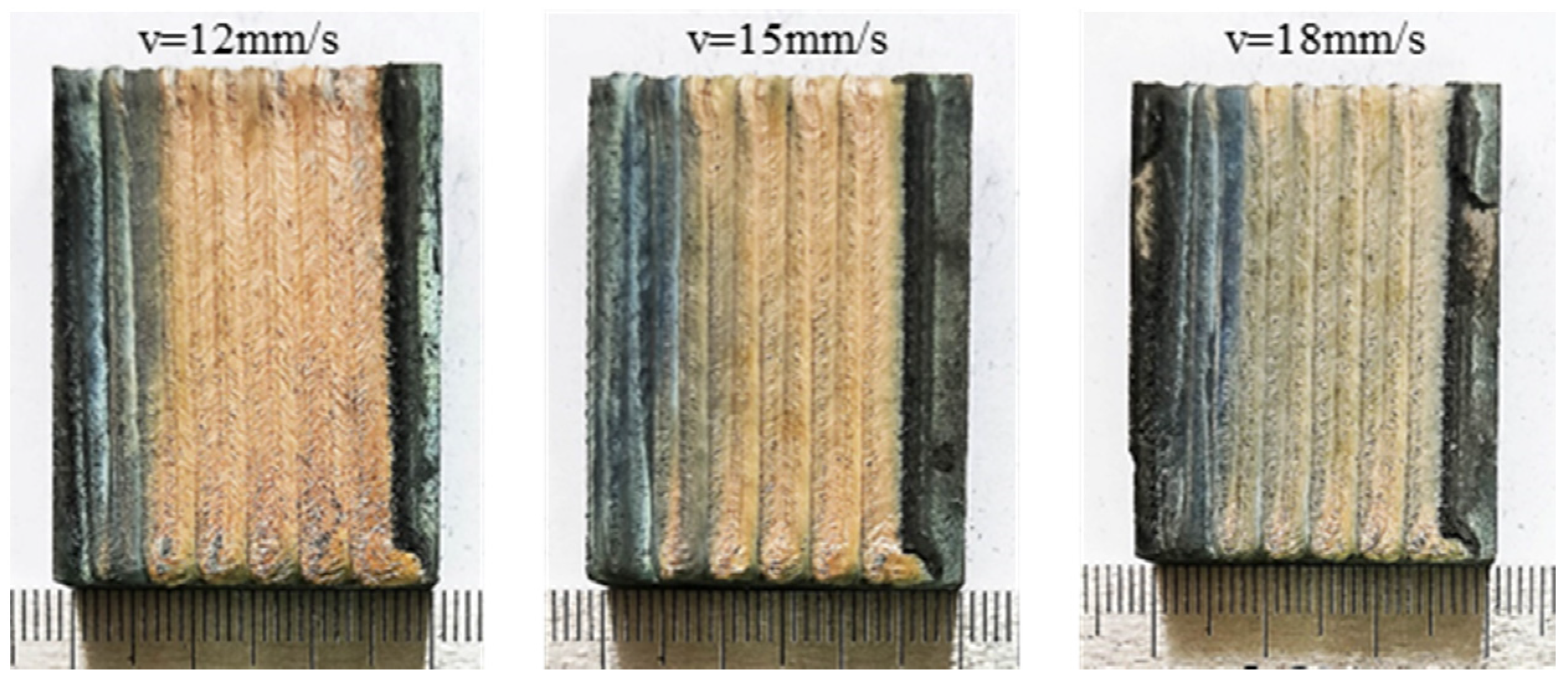

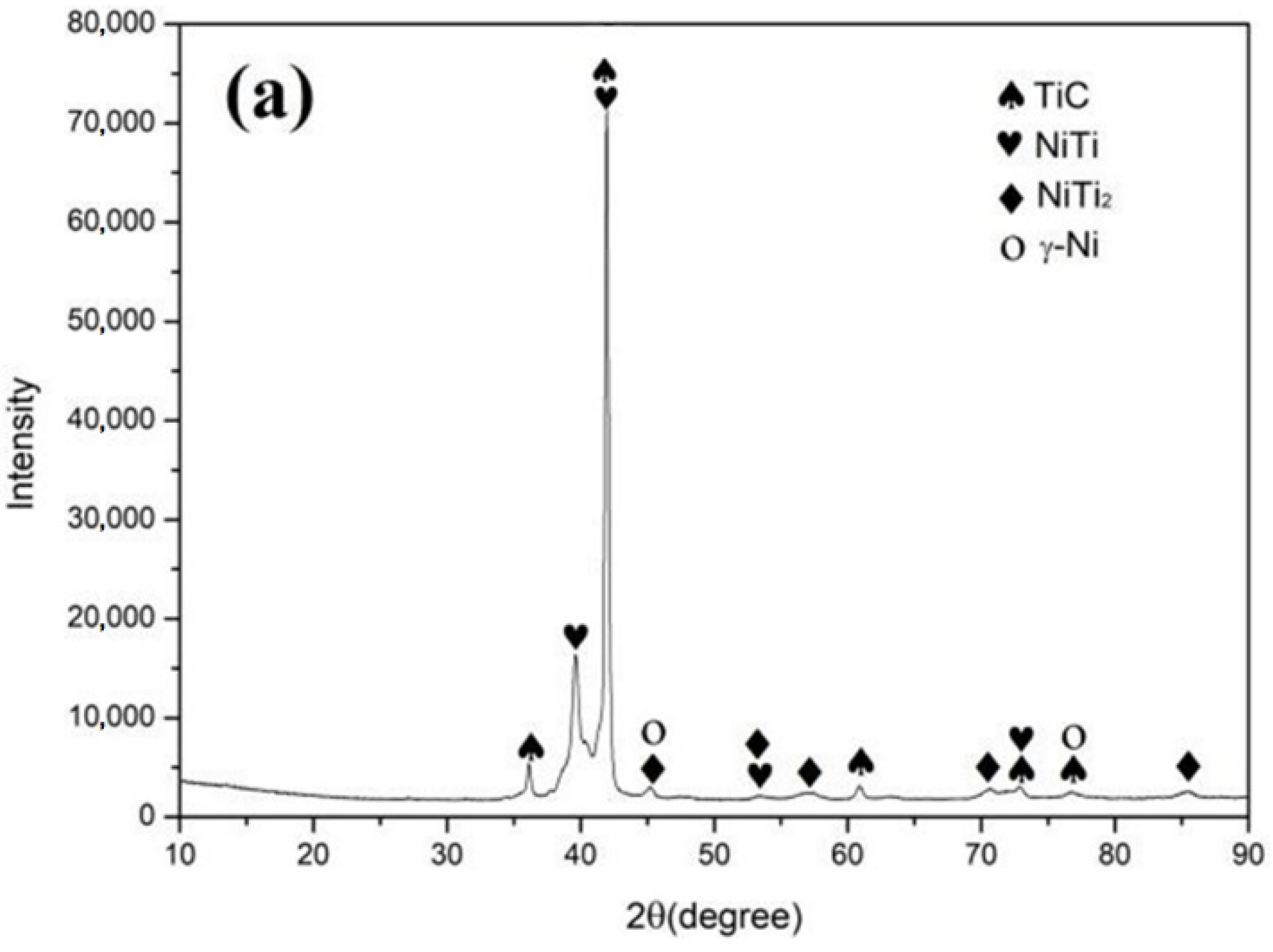



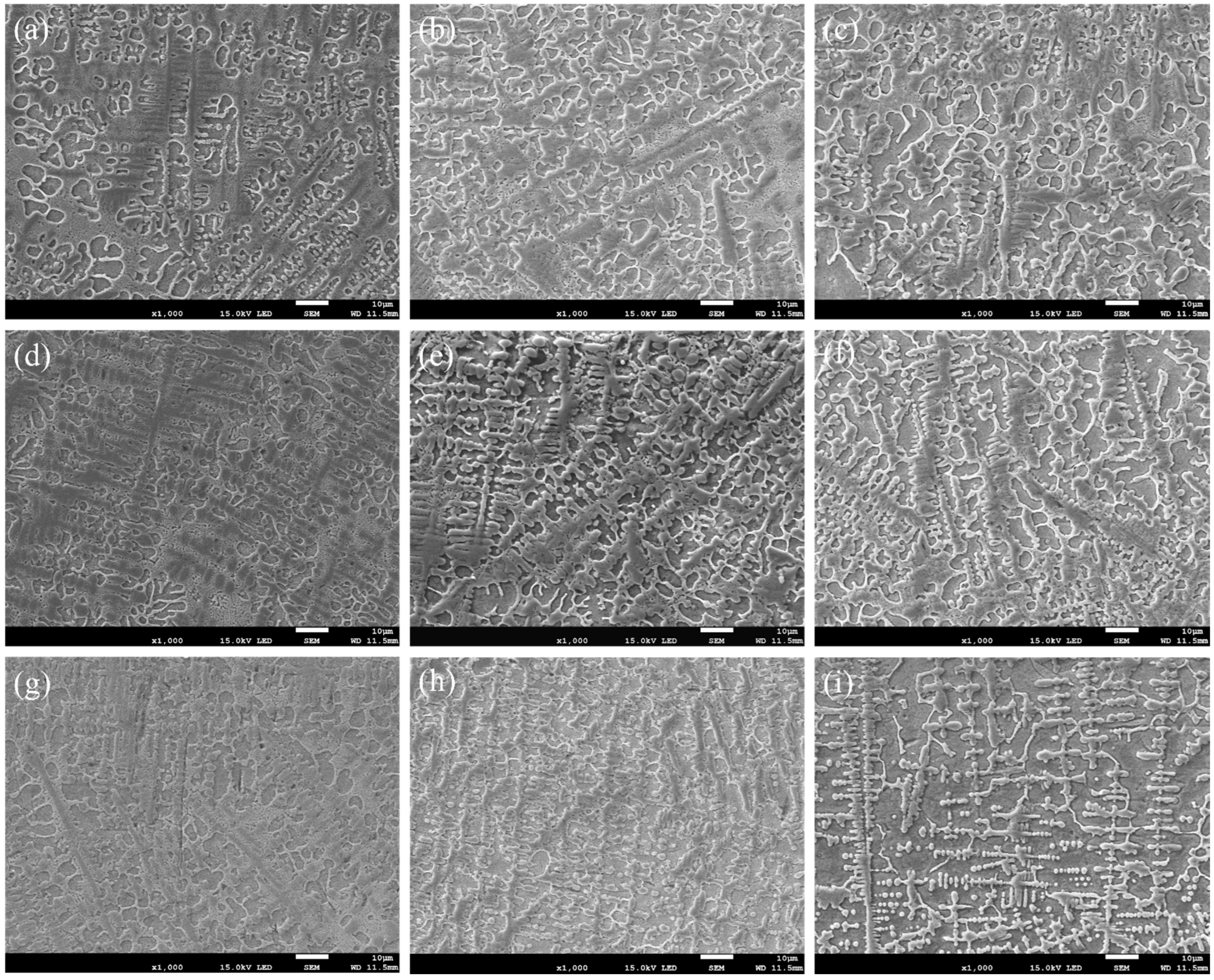

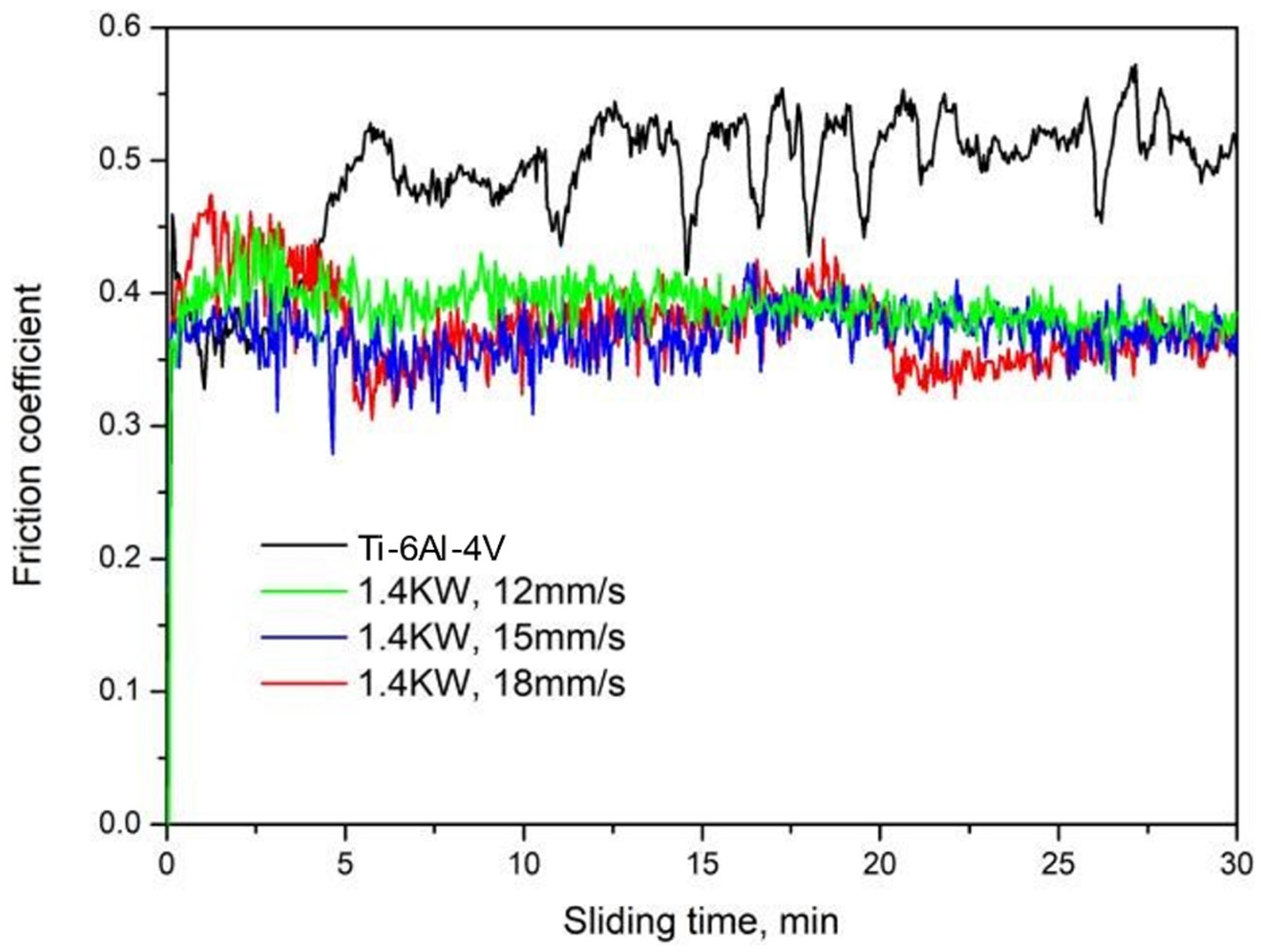
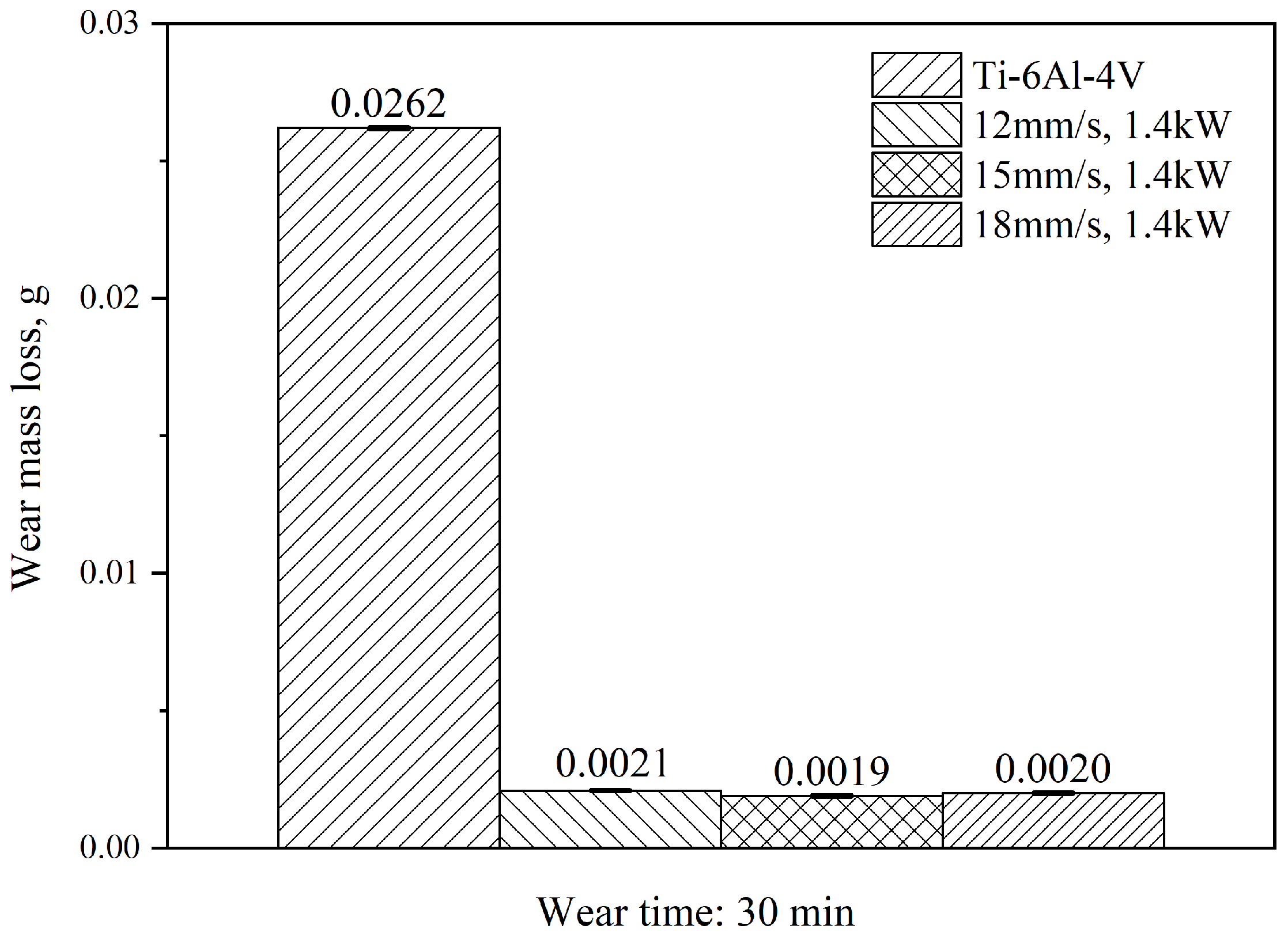


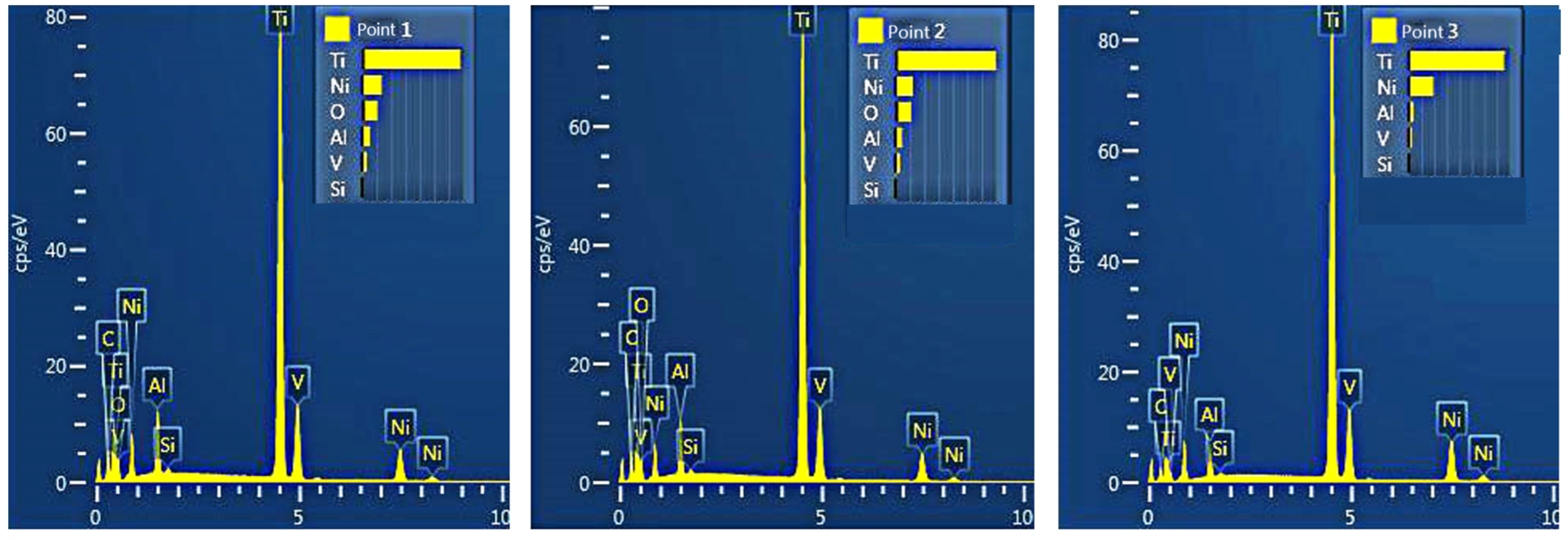
| Elements | Ti | Al | V | Fe | C | N | H | O |
|---|---|---|---|---|---|---|---|---|
| Contents (wt.%) | Balance | 6.0 | 4.1 | 0.18 | 0.01 | 0.01 | 0.006 | 0.12 |
Publisher’s Note: MDPI stays neutral with regard to jurisdictional claims in published maps and institutional affiliations. |
© 2022 by the authors. Licensee MDPI, Basel, Switzerland. This article is an open access article distributed under the terms and conditions of the Creative Commons Attribution (CC BY) license (https://creativecommons.org/licenses/by/4.0/).
Share and Cite
Yu, H.; Meng, X.; Wang, Z.; Chen, C. Influence of Scanning Speed on the Microstructure and Wear Resistance of Laser Alloying Coatings on Ti-6Al-4V Substrate. Materials 2022, 15, 5819. https://doi.org/10.3390/ma15175819
Yu H, Meng X, Wang Z, Chen C. Influence of Scanning Speed on the Microstructure and Wear Resistance of Laser Alloying Coatings on Ti-6Al-4V Substrate. Materials. 2022; 15(17):5819. https://doi.org/10.3390/ma15175819
Chicago/Turabian StyleYu, Huijun, Xiaoxi Meng, Zifan Wang, and Chuanzhong Chen. 2022. "Influence of Scanning Speed on the Microstructure and Wear Resistance of Laser Alloying Coatings on Ti-6Al-4V Substrate" Materials 15, no. 17: 5819. https://doi.org/10.3390/ma15175819





